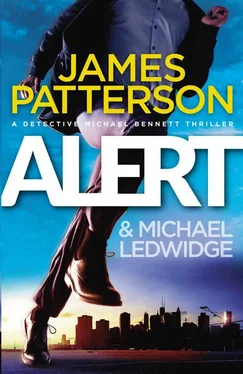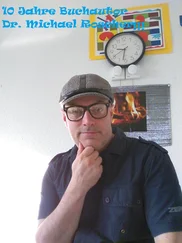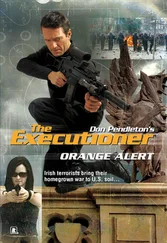“His name is Alex Mirzoyan. He was born in Armenia, came here when he was eleven, lives in Sunny Isles Beach in south Florida. We don’t want to jump to conclusions too quickly, but Sunny Isles Beach is where a lot of the Miami Russian Mafia live. He has the priors of a low-level criminal: credit card fraud, some burglaries, drug possession. But what’s concerning is that last year he traveled to Armenia and stayed there for six months.”
“Armenia? Is that near Russia?” said Arturo.
“Sort of,” I said. “It’s more toward the Middle East. I think it actually borders Iran.”
The room absorbed that in stunned silence.
“The Middle East? Iran?” said Brooklyn. “So we’re thinking terrorism? All this is Islamic terrorism?”
“Now, wait. Slow down,” I said. “We don’t know that. Terrorists take credit, usually, and there’s been nothing but silence, right? Plus we don’t even know if the two things are related yet. The assassination could have been a crime of sick opportunity. Like that nut who sent ricin-laced letters to politicians after nine eleven. We have to treat them as two separate crimes until further notice.”
There were some tentative nods, but even I was unsure about what I’d just said.
Like everybody else, I was freaking out and had no idea whatsoever what the hell was going on.
On the eastern edge of the well-heeled Upper East Side in Manhattan, the crowded and busy neighborhood of Yorkville runs from 59th Street to 96th Street between Lexington Avenue and the East River.
Before 9/11, the neighborhood was the site of the largest disaster in New York City’s history: in 1904, just offshore of Ninetieth Street in the East River, the steamship General Slocum accidentally caught fire and sank, killing more than one thousand passengers.
And now, at exactly 8:15 a.m., Yorkville’s dark history began to repeat itself as a mechanical coughing started up in the two metal boxes that had been illegally positioned the day before at 421 East 81st and 401 East 66th.
The coughing, followed by a revving sound, came from small but quite powerful modified gasoline-powered generators contained inside each device’s metal housing. As the engine rose in pitch, the generator drove its steadily increasing electrical current through a four-foot-wide tightly wound coil of copper wire that was surrounded by a copper tube of equal length. The movement of the current through the copper cylinder instantly began to build an electromagnetic field. One that mounted and mounted as the engine pitched higher and higher, like an opera singer’s crescendo.
Then the explosives packed between the devices’ wire and tubing suddenly went off, sending a massive, invisible electromagnetic pulse in all directions at the speed of light.
The volume of the detonation inside the roof-positioned devices was negligible — a loud electrical pop, like a transformer blowing. But the sudden effect was anything but negligible.
The first official sign that something was wrong was the critical-failure alarm in the busy control room of the city’s Department of Transportation. The supervisor on duty dropped the Red Bull he’d just cracked open when he looked up and saw on the big board that every traffic light from 59th to 90th Street had just gone off-line, as though someone had hit a switch.
The traffic lights weren’t the only things in Yorkville to go off-line. At Gracie Mansion and Rockefeller University and Weill Cornell Medical Center and Memorial Sloan Kettering Cancer Center and Bloomingdale’s and the moneyed Chapin and Brearley schools and every other building within a hundred square blocks, all electrical activity instantly vanished, and every computer and light and elevator immediately ceased to work. It was like the return of the Stone Age.
People screamed and went flying as a packed southbound number 4 train coming into the 86th Street station jerked to a sudden stop. The same thing happened on a smaller but no less terrifying scale as the Roosevelt Island tram car coming out of its concrete berth over Second Avenue and 59th Street slammed to a halt and swung back and forth above the traffic.
It wasn’t just the buildings. In the side streets and avenues and even on the FDR Drive, alongside the East River, the morning rush-hour commute’s cars and delivery vans and taxis and dump trucks en masse began to coast out of control and plow into each other as their engines suddenly and inexplicably failed.
As countless car accidents occurred, pedestrians halted, staring at their suddenly fried cell phones. Shop owners opened the doors of their suddenly darkened businesses and stepped out onto the sidewalks, looking around.
On the riverside jogging path just north of John Jay Park, a female NYU student stopped by the river’s railing to check what was wrong with her suddenly dead iPod. Tugging out the earbuds, she glanced up at a strange low whining sound above her.
Then she screamed and looked, dumbstruck, at the still-spinning rotor blade from a falling traffic helicopter as it missed her head by less than five feet, a split second before it crashed nose-first into the East River.
At a safe distance away, and above the electromagnetic pulse, on the sixty-fifth floor of the Courtyard hotel on Broadway and 54th Street, a man in a white bathrobe stood in the east-facing window of his room with a pair of binoculars.
Behind him came the sudden hiss and pop of radio static followed by a frantic voice. Then another. Then another.
Mr. Beckett lowered his binoculars and turned and smiled at the police-band radio on the table behind him.
The abject confusion from their latest attack was already starting, he thought.
Good.
He smiled at Mr. Joyce, who was sitting in a soft chair beside the radio, also in a white bathrobe, fastidiously clipping his toenails.
Mr. Beckett lifted the mimosa from the room-service cart at his elbow. He raised it in the direction of his friend.
“What shall we toast to, Mr. Joyce?”
“The power of the human imagination, of course, Mr. Beckett,” said Mr. Joyce as he finished his left foot and recrossed his legs and started on the right.
He shrugged.
“What else is there, after all?”
After the conference ended, my team and I set up shop at a couple of desks in a far corner of the crowded, kinetic Intelligence Division bull pen.
Although it was early in the morning, everyone already seemed a little haggard. The cops around me were doing their best to hide it, but it was obvious that people were getting scared. A bombing and an assassination were insane even by New York’s standards.
An hour later, I was still on the horn with the department public relations office trying to disseminate stills of the Washington Heights bombers to the news outlets when it started.
I had just tucked the desk phone receiver under my chin when I suddenly noticed the rhythmic, low-toned, almost subliminal buzzing that had invaded the sterile white office space. When my hip vibrated, I realized that the sound was everyone’s cell phones vibrating.
But why would everyone’s phones be going off at once? I thought, hanging up my desk phone and snatching up my cell.
“Mike, did you hear?” It was Miriam Schwartz on the other end.
“No. What?” I said frantically.
“We’re getting reports of a massive blackout on the East Side of Manhattan. But it’s not just that. The cars have stopped. All the cars are in the streets. They’ve stopped working.”
“The cars have stopped?” I repeated stupidly.
“We just got nuked!” someone called out behind me.
My eyes popped wide open. That couldn’t be true. How could that be true? I thought. Yet I remembered from a late-night History channel show that one of the side effects of a nuclear bomb is frozen cars — the bomb fries all their electronics.
Читать дальше












